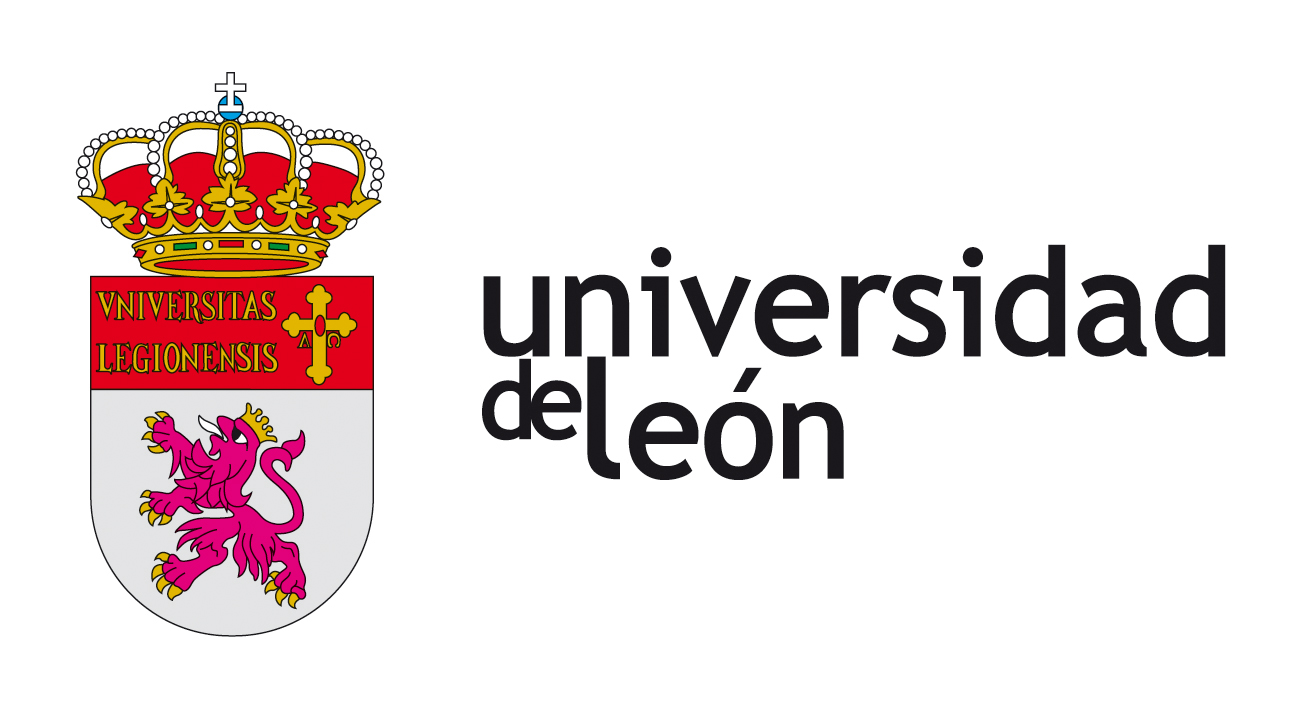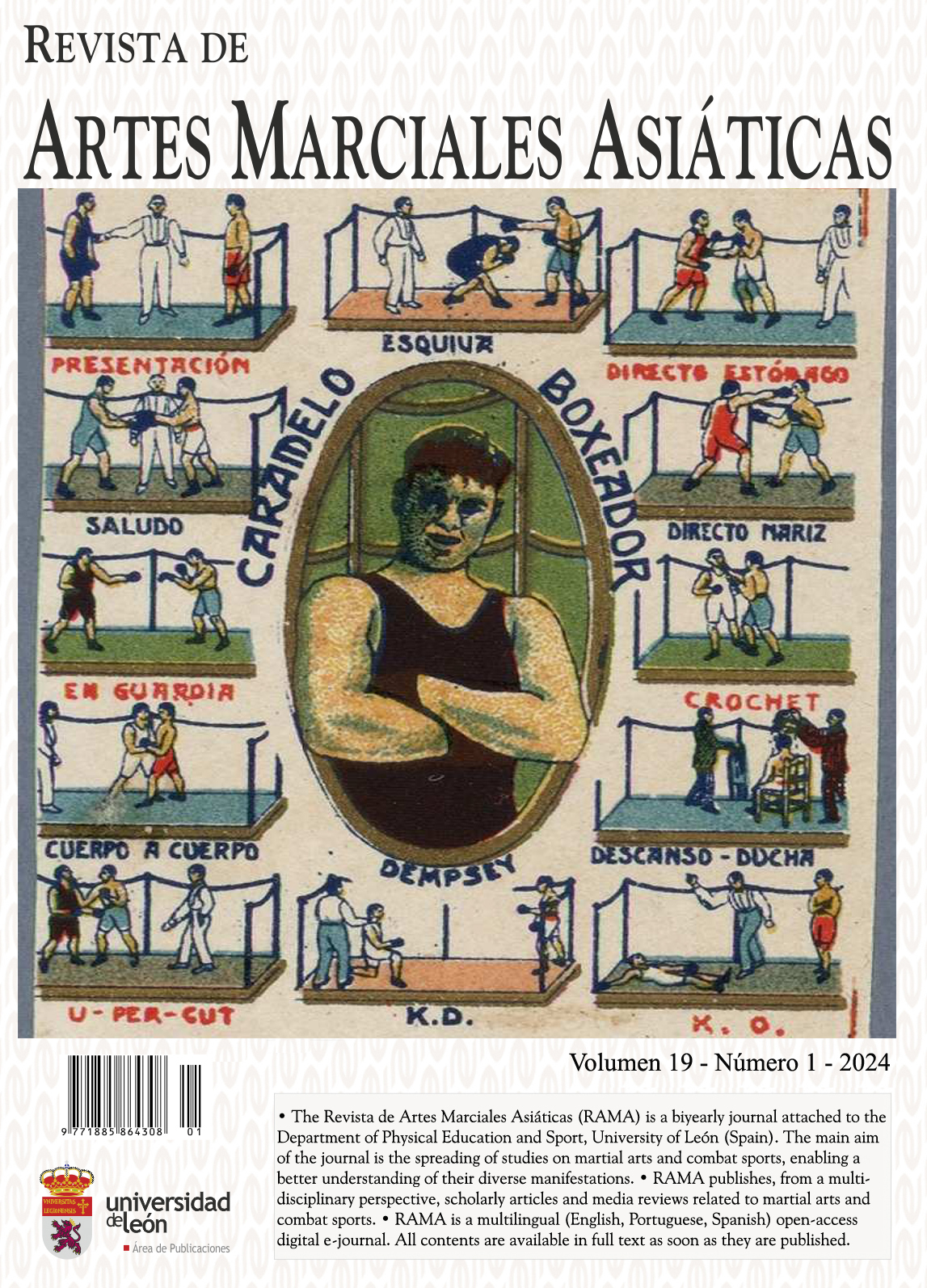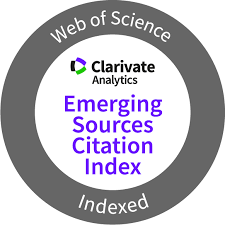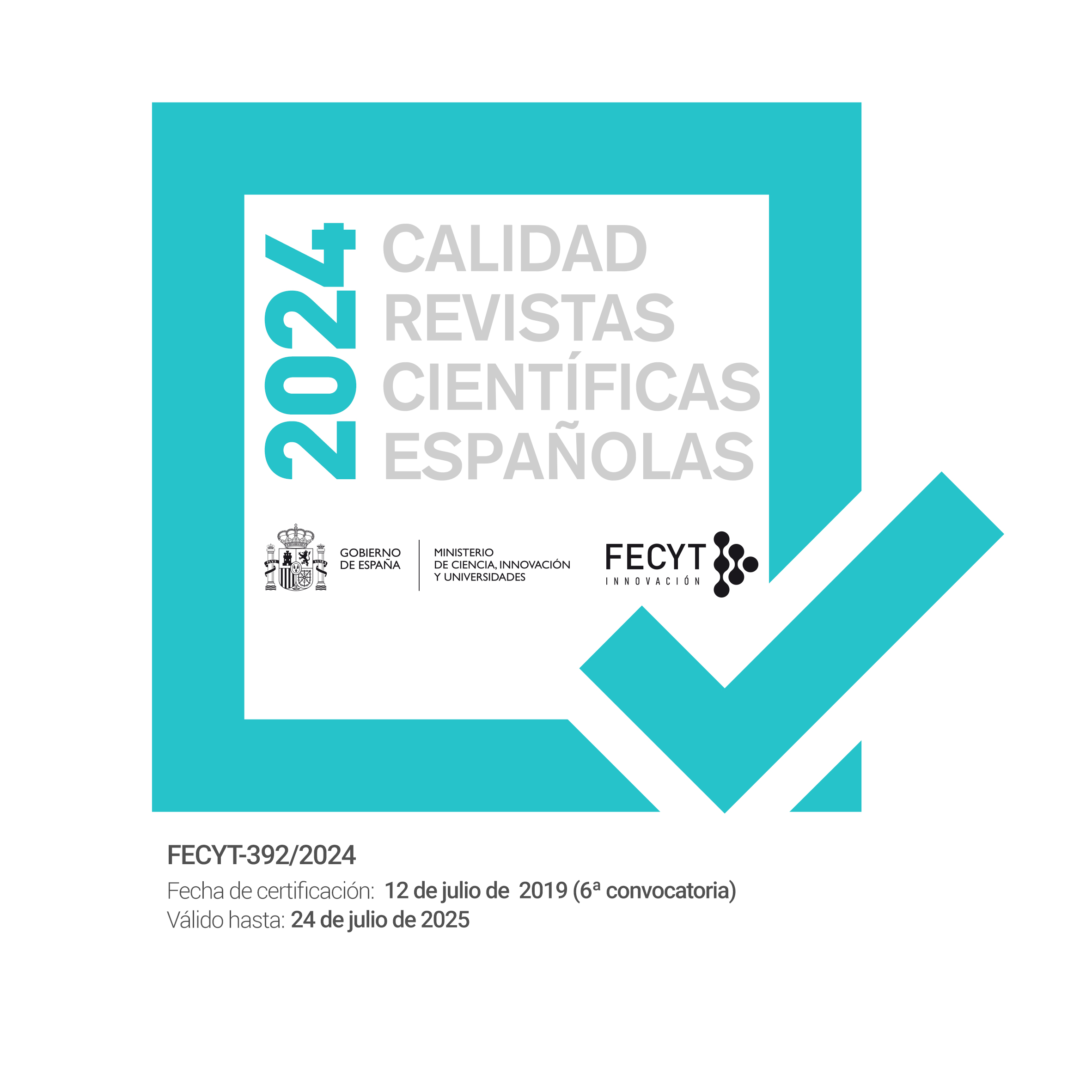El combate de Bruce Lee en pocas palabras: análisis de sus aportaciones a la estrategia a través de sus obras
DOI:
https://doi.org/10.18002/rama.v19i1.2401Palabras clave:
Artes marciales, deportes de combate, Bruce Lee, combate, toma de decisiones, estrategiaAgencias Financiadoras:
The authors received no funding for this workResumen
Esta investigación examina la filosofía de las artes marciales de Bruce Lee, con un enfoque particular en su método único de jeet kune do, para abordar el vacío de rigor científico en el análisis de su metodología marcial. El estudio adopta una estrategia de estudio de caso y emplea el análisis de contenido utilizando el software MaxQDA v.11. Una selección de la literatura oficial de Lee, priorizando escritos inalterados y aquellos que reflejan su pensamiento directo, conforman la muestra de investigación. Los hallazgos principales destacan el desarrollo por parte de Lee de las cinco vías de ataque, demostrando un complejo conocimiento del tiempo, la distancia y el ritmo. Su énfasis en la adaptabilidad en combate resalta la interacción dinámica entre maniobras ofensivas y defensivas. La preferencia de Lee por la parada sobre el bloqueo, su enfoque en la esquiva y conceptos estratégicos como las siete estrellas y los tres frentes subrayan la importancia de proteger las áreas vitales del cuerpo. En resumen, la filosofía de las artes marciales de Bruce Lee se caracteriza por la adaptabilidad, la toma de decisiones estratégicas y la ejecución técnica eficiente. Su enfoque, en constante evolución y rechazando resultados de combate preconcebidos, se sustenta en principios de simplicidad, economía, fluidez y espontaneidad. Este complejo sistema integra estrategias ofensivas y defensivas, reflejando su compromiso con el refinamiento de las artes marciales en una disciplina práctica y reactiva.
Descargas
Métricas alternativas
Citas
Abraham, C., Kingman, J., & Dyson, R. (2001). Maximum velocity of the striking leg during the martial arts front, side and turning kicks and the relationship to technique duration. 19 International Symposium on Biomechanics in Sports, 158-161. https://ojs.ub.uni-konstanz.de/cpa/article/view/3801/3521
Avelar-Rosa, B., & Figueiredo, A. (2012). Initiation to combat sports: Explanation of the structure of the ludic combative phenomenon, by Bruno Avelar & Abel Figueiredo. Revista de Artes Marciales Asiáticas, 4(3), 44-57. https://doi.org/10.18002/rama.v4i3.177
Borysiuk, Z., & Cynarski, W. J. (2009). Reaction time and movement time, types of sensorimotor responses and fencing tempo. Ido Movement for Culture, 9, 189-200.
Bowman, P. (2010). Theorizing Bruce Lee: Film-fantasy-fighting-philosophy. Rodopi.
Bowman, P. (2011). The Fantasy Corpus of Martial Arts, or, The “Communication” of Bruce Lee. In D. S. Farrer & J. Whalen-Bridge (Eds.), Martial Arts as Embodied Knowledge: Asian Traditions in a Transnational World (pp. 61-96). State University of New York Press. https://orca.cardiff.ac.uk/id/eprint/17425/
Bowman, P. (2013). Beyond Bruce Lee: Chasing the Dragon through film, philosophy and popular culture. Wallflower Press.
Chiao, H. P. (1981). Bruce Lee: His Influence on the Evolution of the Kung Fu Genre. Journal of Popular Film and Television, 9(1), 30-42. https://doi.org/10.1080/01956051.1981.10661886
Chung-an Chang. (2022). The World Literature of Bruce Lee by Way of Cross-Cultural Adaptations and Translations. Tamkang Review, 53(1), 63–91. https://doi.org/10.6184/TKR.202212_53(1).0003
Collins, D., Bobrownicki, R., Carson, H. J., & MacPherson, A. C. (2023). ‘It is difficult to understand the universe if you only study one planet’: A response to Myszka, Yearby and Davids. Sport, Education and Society, 1–5. https://doi.org/10.1080/13573322.2023.2235857
Creswell, J. W. (2007). Qualitative inquiry & research design: Choosing among five approaches (2nd ed.). Sage.
Denzin, N. K., & Lincoln, Y. S. (2011). Introduction: The Discipline and Practice of Qualitative Research. In N. K. Denzin & Y. S. Lincoln (Eds.), The Sage handbook of qualitative research (4th ed., pp. 1-20). Sage.
Estevan, I., Jandacka, D., & Falco, C. (2013). Effect of stance position on kick performance in taekwondo. Journal of Sports Sciences, 31(16), 1815-1822. https://doi.org/10.1080/02640414.2013.803590
Falcó Pérez, C., Molina-García, J., Álvarez, O., & Estevan, I. (2013). Effects of target distance on select biomechanical parameters in taekwondo roundhouse kick. Sports Biomechanics, 12(4), 381-388. https://doi.org/10.1080/14763141.2013.776626
Fernandes, FM., Wichi, RB., Silva, VF., Ladeira, APX., & Ervilha, UF. (2011). Biomechanical methods applied in martial arts studies. Journal of Morphological Science, 28(3), 141-144.
González de Prado, C. (2011). Caracterización técnico-táctica de la competición de combate de alto nivel en Taekwondo. Efectividad de las acciones tácticas [Universidad de Barcelona]. http://hdl.handle.net/2445/43118
Guo, P., Ma, S., & Li, W. (2017). An examination of Bruce Lee’s kung fu from the perspective of Japanese martial arts: The Chinese culture of chivalrous heroes and Western science. Asia Pacific Journal of Sport and Social Science, 6(2), 126–142. https://doi.org/10.1080/21640599.2017.1323821
Hagemann, N., Schorer, J., Cañal-Bruland, R., Lotz, S., & Strauss, B. (2010). Visual perception in fencing: Do the eye movements of fencers represent their information pickup? Attention, perception & psychophysics, 72(8), 2204-2214. https://doi.org/10.3758/APP.72.8.2204
Harris, L. J. (2010). In fencing, what gives left-handers the edge? Views from the present and the distant past. Laterality, 15(1-2), 15-55. https://doi.org/10.1080/13576500701650430
Hristovski, R., Davids, K., Araújo, D., & Button, C. (2006). How Boxers Decide to Punch a Target: Emergent Behaviour in Nonlinear Dynamical Movement Systems. Journal of Sports Science & Medicine, 5(CSSI), 60-73.
Hsieh, H.-F., & Shannon, S. E. (2005). Three approaches to qualitative content analysis. Qualitative Health Research, 15(9), 1277-1288. https://doi.org/10.1177/1049732305276687
Hu, B. (2008). ‘Bruce Lee’ after Bruce Lee: A life in conjectures. Journal of Chinese Cinemas, 2(2), 123-135. https://doi.org/10.1386/jcc.2.2.123_1
Hurley, S. (2021). The “Ultimate Athlete:” Bruce Lee, Martial Arts and the Pursuit of Human Perfection. In A. Hiroshi, P. W. Galbraith, & M. Kovacic (Eds.), Idology in Transcultural Perspective (pp. 133–157). Springer. https://doi.org/10.1007/978-3-030-82677-2_6
Jennings, G. (2019). Bruce Lee and the Invention of Jeet Kune Do: The Theory of Martial Creation. Martial Arts Studies, 0(8), Article 0. https://doi.org/10.18573/mas.84
Krefting, L. (1991). Rigor in qualitative research: The assessment of trustworthiness. The American Journal of Occupational Therapy: Official Publication of the American Occupational Therapy Association, 45(3), 214–222. https://doi.org/10.5014/ajot.45.3.214
Krippendorff, K. (2004). Content analysis: An introduction to its methodology (2nd ed.). Sage.
Kronlund, M. (1984). Enseñanza de la esgrima de florete: Tecnica, terminologia, pedagogia y normas de competicion. Gymnos.
Lee, B. (1968a). Bruce Lee talks back. Black Belt Magazine, 6(1), 23-25.
Lee, B. (1968b). By the way. Black Belt Magazine, 6(2), 3-4, 63.
Lee, B. (2008). Chinese Gung Fu: The philosophical art of self-defense (S. Dzida & J. Santiago, Eds.; 4th ed.). Black Belt Books.
Lee, B. (2011). Tao of Jeet Kune Do: New expanded edition (K. Storti, S. Dzida, A. Hartunian, & J. Santiago, Eds.). Black Belt Books.
Lee, B., & Uyehara, M. (2008). Bruce Lee’s fighting method: The complete edition (S. Dzida, J. Sattler, & J. Santiago, Eds.). Black Belt Books.
Lincoln, Y.S., & Guba, E.G. (1985). Naturalistic Inquiry. Sage.
Little, J. R. (Ed.). (1997a). Jeet Kune Do: Bruce Lee’s commentaries on the martial way. Tuttle Publishing.
Little, J. R. (Ed.). (1997b). The Tao of Gung Fu: A study in the way of Chinese martial art. Tuttle Publishing.
Little, J. R. (Ed.). (1997c). Words of the dragon: Interviews 1958-1973. Tuttle Publishing.
Little, J. R. (Ed.). (1998). Letters of the dragon: An anthology of Bruce Lee’s correspondence with family, friends, and fans, 1958-1973. Tuttle Publishing.
Little, J. R. (Ed.). (1999). Bruce Lee: Artist of Life. Tuttle Publishing.
Marshall, C., & Rossman, G. B. (2011). Designing qualitative research (5th ed.). Sage.
Martínez de Quel, Ó., López, E., Sillero, M., & Saucedo, F. (2011). Decision making in fencing training and its relationship with reaction time. e-balonmano.com: Revista de Ciencias del Deporte, 7(1), 3-12.
Myszka, S., Yearby, T., & Davids, K. (2023). Being Water: How key ideas from the practice of Bruce Lee align with contemporary theorizing in movement skill acquisition. Sport, Education and Society, 1–17. https://doi.org/10.1080/13573322.2022.2160701
Ongiri, A. A. (2002). «He wanted to be just like Bruce Lee»: African Americans, Kung Fu Theater and Cultural Exchange at the Margins. Journal of Asian American Studies, 5(1), 31-40. https://doi.org/10.1353/jaas.2002.0009
Parlebas, P. (2001). Juegos, deportes y sociedades: Léxico de praxiología motriz. Paidotribo.
Petrov, R. (1977). Principles of free-style wrestling for children and adolescents. Federación Española de Lucha.
Pobratyn, A., Ciesielska, Z., Lesiak, K., & Ziental, A. (2017). Eastern Martial Arts in cinematography and popularising a healthy lifestyle—Interpretation sketch. Physical Activity Review, 5, 78-82. https://doi.org/10.16926/par.2017.05.11
Pollard, M. (1967). Is the Green Hornet’s version of gung-fu genuine? Black Belt Magazine, 5(10), 14-18.
Prashad, V. (2003). Bruce Lee and the Anti-imperialism of Kung Fu: A Polycultural Adventure. Positions: Asia critique, 11(1), 51-90. https://doi.org/10.1215/10679847-11-1-51
Rodríguez-Sánchez, A. R. (2019). The Inheritance of the Little Dragon: Contributions to the Concept of the Combat Duel in the Work of Bruce Lee. Ido Movement for Culture, 19, 22–25. https://doi.org/10.14589/ido.19.4.4
Saldaña, J. (2016). The coding manual for qualitative researchers (3rd ed.). Sage.
Saucedo, F., & Martínez de Quel, Ó. (2000). El trabajo de la táctica en el karate: Propuesta de un modelo de enseñanza. En J. P. Fuentes García & M. Macías García (Eds.), I Congreso Internacional de la Asociación Española de Ciencias del Deporte (pp. 153-160). Facultad de Ciencias del Deporte (Universidad de Extremadura). https://cienciadeporte.eweb.unex.es/congreso/00 cac/RD/ED/19karate.pdf
Shu, Y. (2003). Reading the Kung Fu Film in an American Context: From Bruce Lee to Jackie Chan. Journal of Popular Film and Television, 31(2), 50-59. https://doi.org/10.1080/01956050309603666
Sieber, L., Cynarski, W. J., & Litwiniuk, A. (2007). Spheres of fight in martial arts. Archives of Budo, 3, 42-48.
Strauch, H., Wirth, I., Taymoorian, U., & Geserick, G. (2001). Kicking to death—Forensic and criminological aspects. Forensic Science International, 123(2-3), 165-171. https://doi.org/10.1016/S0379-0738(01)00542-4
Wąsik, J., Mosler, D., Góra, T., & Scurek, R. (2023). Conception of effective mass and effect of force – measurement of taekwon-do master. Physical Activity Review, 11(1), 11-16. https://doi.org/10.16926/par.2023.11.02
Descargas
Publicado
Cómo citar
Número
Sección
Licencia
Derechos de autor 2024 Augusto Rembrandt Rodríguez-Sánchez, Joaquín Piedra, Gonzalo Ramírez-Macías

Esta obra está bajo una licencia internacional Creative Commons Atribución-NoComercial-CompartirIgual 4.0.
Los autores que publican en esta revista están de acuerdo con los siguientes términos:
- Los autores ceden de forma no exclusiva los derechos de explotación (reproducción, distribución, comunicación pública, transformación) a la Universidad de León, por lo que pueden establecer, por separado, acuerdos adicionales para la distribución no exclusiva de la versión de la obra publicada en la revista (por ejemplo, alojarlo en un repositorio institucional o publicarlo en un libro), con un reconocimiento de su publicación inicial en esta revista.
- Este trabajo se encuentra bajo la Creative Commons Attribution-NonCommercial-ShareAlike 4.0 International License. Puede consultarse desde aquí la versión informativa y el texto legal de la licencia.
- Se permite y se anima a los autores a difundir electrónicamente las versiones pre-print (versión antes de ser evaluada) y/o post-print (versión evaluada y aceptada para su publicación) de sus obras antes de su publicación, ya que favorece su circulación y difusión más temprana y con ello un posible aumento en su citación y alcance entre la comunidad académica.











